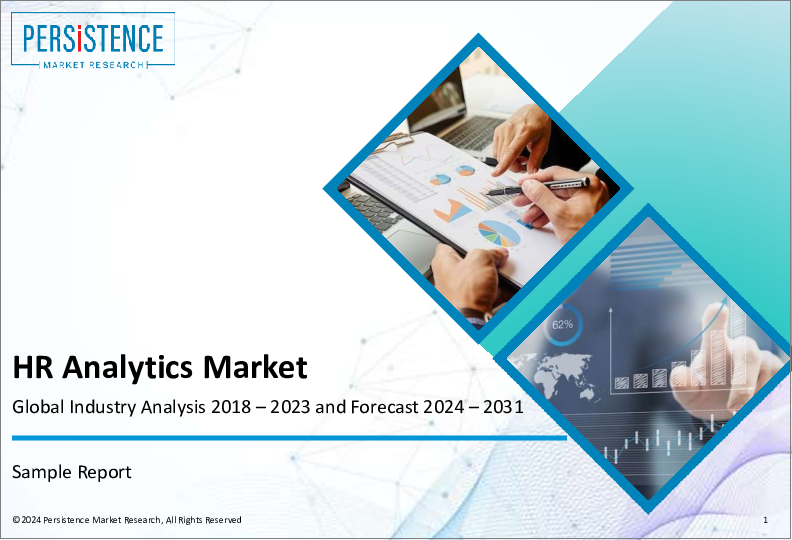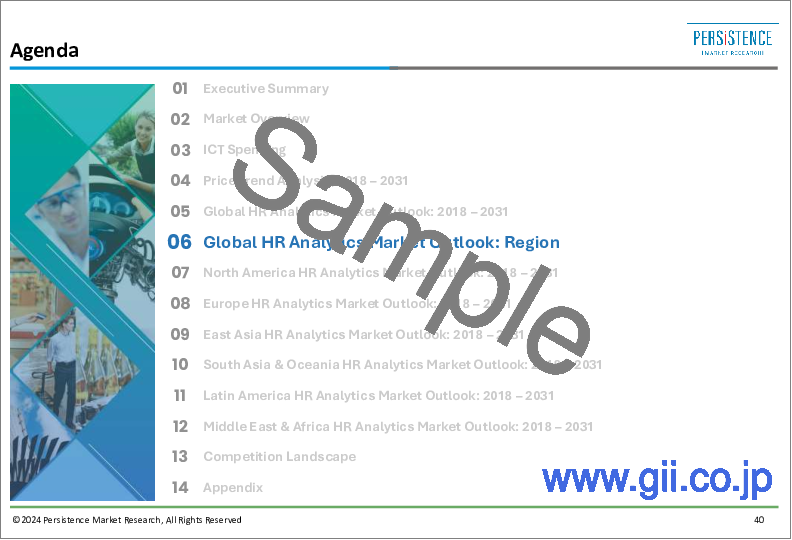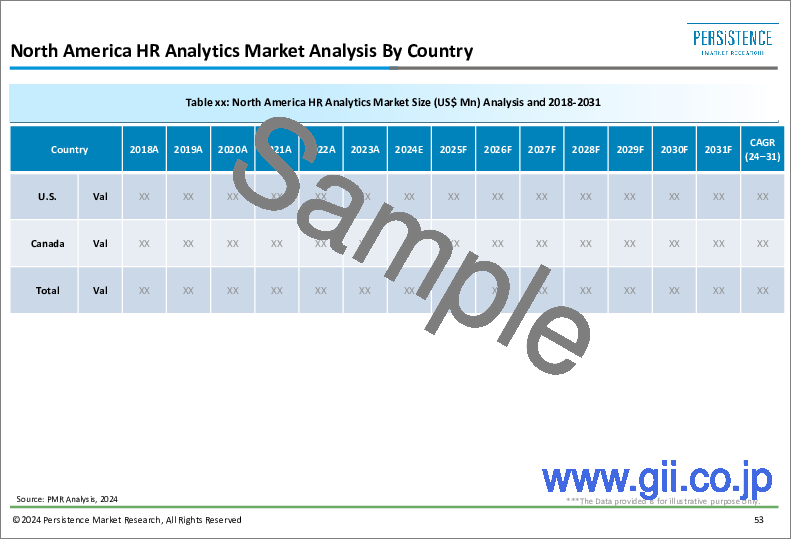|
|
市場調査レポート
商品コード
1482389
HRアナリティクス市場:地域別(北米、欧州、アジア太平洋、ラテンアメリカ、中東アフリカ):世界の産業分析、規模、シェア、成長、動向、2024年~2032年予測HR Analytics Market by Geography (North America, Europe, Asia Pacific, Latin America, and the Middle East and Africa): Global Industry Analysis, Size, Share, Growth, Trends, and Forecast, 2024-2032 |
||||||
カスタマイズ可能
|
|||||||
| HRアナリティクス市場:地域別(北米、欧州、アジア太平洋、ラテンアメリカ、中東アフリカ):世界の産業分析、規模、シェア、成長、動向、2024年~2032年予測 |
|
出版日: 2024年05月10日
発行: Persistence Market Research
ページ情報: 英文 341 Pages
納期: 2~5営業日
|
全表示
- 概要
- 目次
Persistence Market Research社はこのほど、HRアナリティクス市場の詳細な分析を実施し、その世界の状況を幅広く掘り下げた包括的なレポートを発行しました。この詳細な出版物は、市場力学、動向、機会、課題に関する貴重な洞察を提供し、その構造の完全な概要を提供します。本調査では、独自のデータと統計の裏付けにより、2024年から2032年にわたるHRアナリティクス市場の予測成長軌道を予測しています。
HRアナリティクス市場は、2024年から2032年にかけて12.4%の有望なCAGRで着実に成長すると予測されています。2024年の市場規模は25億3,000万米ドルで、2032年には90億米ドルに達する見込みです。
主な洞察
- HRアナリティクス市場のCAGR(2024年~2032年):12.4%
- HRアナリティクス市場価値(2024年):25億3,000万米ドル
- HRアナリティクス市場価値(2032年):90億米ドル
HRアナリティクス市場-調査範囲
HRアナリティクス・ソリューションに対する需要の急増は、主にHRプロセスと最先端テクノロジーの統合や、新しい従業員を採用する部門の世界の拡大によってもたらされています。この動向により、企業は最新の人事慣行、ソリューション、ツールの導入を迫られています。
HRアナリティクス市場が現在上昇基調にあるのは、人材獲得、定着、採用、従業員エンゲージメントといった重要なプロセスへの複数の部門の関与が増加していることを示しています。HRアナリティクス・システムは、さまざまなHRアナリティクス・ツールの助けを借りてデータの保存、セグメンテーション、分析を容易にし、これらの複雑なプロセスを合理化する上で極めて重要な役割を果たします。
市場成長の促進要因
データ主導の意思決定に対する需要:組織は、情報に基づいた意思決定を行う上でのデータの価値をますます認識するようになっています。HRアナリティクスは、従業員の動向、従業員のパフォーマンス、人材管理に関する貴重な洞察を提供し、効率性と生産性を向上させるためのデータ主導の意思決定を行う権限を組織に与えます。
従業員のエンゲージメントとリテンションに注力:人材争奪戦が激化する中、組織は従業員のエンゲージメントとリテンションを重視するようになっています。HRアナリティクスによって、組織は従業員の感情を分析し、エンゲージメントに影響を与える要因を特定し、定着率を高める戦略を策定して、最終的に離職コストを削減することができます。
テクノロジーの進歩:特に人工知能(AI)、機械学習、予測分析などの技術の進歩が、HRアナリティクス市場の成長に拍車をかけています。これらの技術により、人員計画のための予測モデリング、将来性の高い従業員の特定、将来の人材ニーズの予測など、人事データのより高度な分析が可能になります。
市場抑制要因
データのプライバシーとセキュリティに関する懸念:従業員データの収集と分析には、プライバシーとセキュリティに関する懸念がつきまとう。企業は、GDPRやCCPAなどの複雑な規制の枠組みを乗り越えてコンプライアンスを確保し、不正アクセスや悪用から従業員データを保護しなければならないです。
導入の課題:HRアナリティクス・ソリューションの導入には、テクノロジー、インフラ、従業員トレーニングへの多額の投資が必要です。組織は、人事分析システムを既存のHRIS(人事情報システム)と統合し、異なるプラットフォーム間でデータの品質と一貫性を確保するという課題に直面する可能性があります。
機会
人工知能と機械学習の統合:AIと機械学習の進歩は、人事分析ソリューションの機能を強化する機会を提供します。AIを活用したアルゴリズムを導入することで、要員計画、人材獲得、従業員定着のための予測分析が可能になり、企業はプロアクティブな意思決定を行うための貴重な洞察を得ることができます。
クラウドベースのソリューションの拡大:クラウドベースの人事分析ソリューションへのシフトは、大きな成長機会をもたらします。クラウドベースのプラットフォームは拡張性、柔軟性、アクセシビリティを提供するため、組織はインフラに多額の先行投資をすることなく、人事分析ツールの導入と管理が容易になります。ベンダーは、さまざまな業種や組織規模のニーズに合わせた拡張性とカスタマイズ性の高いクラウドベースのソリューションを提供することで、この動向を活用することができます。
レポートが回答する主な質問
- HRアナリティクス市場の現在の規模と成長率は?
- HRアナリティクス市場の成長を促進する主な要因は何か?
- 市場の成長を妨げる主な課題と障壁は何か?
- HRアナリティクス市場の新たな動向と機会は何か?
- HRアナリティクスソリューションの主な用途と使用事例は?
目次
第1章 エグゼクティブサマリー
第2章 市場概要
- 市場の範囲と定義
- 市場力学
- 促進要因
- 抑制要因
- 機会
- 課題
- 主な動向
- HRアナリティクス市場:バリューチェーン
- マクロ経済要因
- 世界のセクター別展望
- 世界のGDP成長見通し
- 予測要因-関連性と影響
- COVID-19の影響評価
- PESTLE分析
- ポーターファイブフォースの分析
第3章 ICT支出
第4章 価格分析
- 価格分析
- サブスクリプションモデル
- 永久ライセンス
第5章 世界のHRアナリティクス市場の展望:過去(2019年~2023年)と予測(2024年~2032年)
- 主なハイライト
- 市場規模と前年比成長率
- 絶対的な$機会
- 市場規模(金額)分析と予測
- 過去の市場規模分析、2019-2023
- 現在の市場規模予測、2024~2032年
- 世界のHRアナリティクス市場の展望:展開
- イントロダクション/主な調査結果
- 過去の市場規模(金額)分析、2019-2023年
- 現在の市場規模(金額)予測、2024~2032年
- オンプレミス
- クラウド
- 市場の魅力分析:展開
- 世界のHRアナリティクス市場の展望:構成要素
- イントロダクション/主な調査結果
- 過去の市場規模(金額)分析、2019-2023年
- 現在の市場規模(金額)予測、2024~2032年
- 解決
- サービス
- 実装および統合サービス
- アドバイザリーサービス
- サポートおよびメンテナンスサービス
- 市場の魅力分析:構成要素
- 世界のHRアナリティクス市場の展望:応用分野
- イントロダクション/主な調査結果
- 過去の市場規模(金額)分析、2019-2023年
- 現在の市場規模(金額)予測、2024~2032年
- 給与計算
- 保持
- 採用
- 人材管理
- 従業員エンゲージメント
- 従業員の育成
- 市場魅力度分析:応用分野
第6章 世界のHRアナリティクス市場の展望:地域
- 主なハイライト
- 過去の市場規模(金額)分析、2019-2023年
- 現在の市場規模(金額)予測、2024~2032年
- 北米
- 欧州
- 東アジア
- 南アジアとオセアニア
- ラテンアメリカ
- 中東・アフリカ
- 市場の魅力分析:地域
第7章 北米のHRアナリティクス市場の展望
第8章 欧州のHRアナリティクス市場の展望
第9章 東アジアのHRアナリティクス市場の展望
第10章 南アジアおよびオセアニアのHRアナリティクス市場の展望
第11章 ラテンアメリカのHRアナリティクス市場の展望
第12章 中東およびアフリカのHRアナリティクス市場の展望
第13章 競合情勢
- 市場シェア分析、2024年
- 市場構造
- 市場別の競合激化マップ
- 競合ダッシュボード
- 企業プロファイル(詳細-概要、財務、戦略、最近の動向)
- SAP
- Oracle
- Infor
- Kronos
- Workday
- Talentsoft
- Sisense Inc
- Sage Group plc
- Kronos Incorporated
- Legartise
- Crunchr
- Microstrategy Incorporated
- INFOR INC
- zoho corporation
- Zoios
第14章 付録
- 調査手法
- 調査の前提条件
- 頭字語と略語
Persistence Market Research recently conducted an in-depth analysis of the HR Analytics Market, resulting in a comprehensive report that delves extensively into its global landscape. This detailed publication provides valuable insights into the market's dynamics, trends, opportunities, and challenges, offering a thorough overview of its structure. With the support of exclusive data and statistics, the research predicts the anticipated growth trajectory of the HR Analytics Market spanning from 2024 to 2032.
The HR analytics market is projected to grow steadily at a promising CAGR of 12.4% from 2024 to 2032. With a value of US$ 2.53 billion in 2024, it is expected to reach US$ 9 billion by 2032.
Key Insights:
- HR Analytics Market CAGR (2024-2032): 12.4%
- HR Analytics Market Value (2024): US$ 2.53 Bn
- HR Analytics Market Value (2032): US$ 9 Bn
HR Analytics Market - Report Scope
The surge in demand for HR analytics solutions is primarily driven by the integration of HR processes with cutting-edge technology and the expansion of sectors engaging new employees globally. This trend is compelling organizations to adopt the latest HR practices, solutions, and tools.
The current upward trajectory of the HR analytics market is indicative of the increasing involvement of multiple sectors in critical processes like talent acquisition, retention, recruitment, and employee engagement. HR analytics systems play a pivotal role in streamlining these intricate processes, facilitating data storage, segmentation, and analysis with the aid of various HR analytics tools.
Market Growth Drivers
Demand for Data-Driven Decision Making: Organizations are increasingly recognizing the value of data in making informed decisions. HR analytics provides valuable insights into workforce trends, employee performance, and talent management, empowering organizations to make data-driven decisions to improve efficiency and productivity.
Focus on Employee Engagement and Retention: With the war for talent intensifying, organizations are placing greater emphasis on employee engagement and retention. HR analytics enables organizations to analyze employee sentiment, identify factors influencing engagement, and develop strategies to enhance retention rates, ultimately reducing turnover costs.
Advancements in Technology: Technological advancements, particularly in artificial intelligence (AI), machine learning, and predictive analytics, are fueling the growth of the HR analytics market. These technologies enable more sophisticated analysis of HR data, including predictive modeling for workforce planning, identifying high-potential employees, and predicting future talent needs.
Market Restraints
Data Privacy and Security Concerns: The collection and analysis of employee data raise concerns about privacy and security. Organizations must navigate complex regulatory frameworks such as GDPR and CCPA to ensure compliance and protect employee data from unauthorized access or misuse.
Implementation Challenges: Implementing HR analytics solutions requires substantial investment in technology, infrastructure, and employee training. Organizations may face challenges in integrating HR analytics systems with existing HRIS (Human Resource Information Systems) and ensuring data quality and consistency across different platforms.
Opportunities
Integration of Artificial Intelligence and Machine Learning: Advancements in AI and machine learning offer opportunities to enhance the capabilities of HR analytics solutions. Implementing AI-powered algorithms can enable predictive analytics for workforce planning, talent acquisition, and employee retention, providing organizations with valuable insights to make proactive decisions.
Expansion of Cloud-Based Solutions: The shift towards cloud-based HR analytics solutions presents significant growth opportunities. Cloud-based platforms offer scalability, flexibility, and accessibility, making it easier for organizations to deploy and manage HR analytics tools without significant upfront investments in infrastructure. Vendors can capitalize on this trend by offering scalable and customizable cloud-based solutions tailored to the needs of different industries and organizational sizes.
Key Questions Answered in Report::
- What is the current size and growth rate of the HR analytics market?
- What are the main drivers driving the growth of the HR analytics market?
- What are the major challenges and barriers hindering market growth?
- What are the emerging trends and opportunities in the HR analytics market?
- What are the main applications and use cases of HR analytics solutions?
Key Companies Profiled
- SAP
- Oracle
- Infor
- Kronos
- Workday
- IBM
- Sage Software
- Microstrategy
- Tableau
- Zoho
HR Analytics Market Segmentation:
By Components
- Solution
- Service
Implementation and Integration Services
Advisory Services
Support and Maintenance Service
By Application Area
- Payroll
- Retention
- Recruitment
- Workforce Management
- Employee Engagement
- Employee Development
By Deployment
- On-premise
- Cloud
By Region
- North America
- Latin America
- Europe
- APAC
- Middle East & Africa"
Table of Contents
1. Executive Summary
- 1.1. Global HR Analytics Market Snapshot, 2024-2032
- 1.2. Market Opportunity Assessment, 2024-2032, US$ Mn
- 1.3. Key Market Trends
- 1.4. Future Market Projections
- 1.5. Premium Market Insights
- 1.6. Industry Developments and Key Market Events
- 1.7. PMR Analysis and Recommendations
2. Market Overview
- 2.1. Market Scope and Definition
- 2.2. Market Dynamics
- 2.2.1. Drivers
- 2.2.2. Restraints
- 2.2.3. Opportunity
- 2.2.4. Challenges
- 2.2.5. Key Trends
- 2.3. HR Analytics Market: Value Chain
- 2.4. Macro-Economic Factors
- 2.4.1. Global Sectorial Outlook
- 2.4.2. Global GDP Growth Outlook
- 2.5. Forecast Factors - Relevance and Impact
- 2.6. Covid-19 Impact Assessment
- 2.7. PESTLE Analysis
- 2.8. Porter Five Force's Analysis
3. ICT Spending
4. Pricing Analysis
- 4.1. Pricing Analysis
- 4.1.1. Subscription Model
- 4.1.2. Perpetual License
5. Global HR Analytics Market Outlook: Historical (2019-2023) and Forecast (2024-2032)
- 5.1. Key Highlights
- 5.1.1. Market Size and Y-o-Y Growth
- 5.1.2. Absolute $ Opportunity
- 5.2. Market Size (US$ Mn) Analysis and Forecast
- 5.2.1. Historical Market Size Analysis, 2019-2023
- 5.2.2. Current Market Size Forecast, 2024-2032
- 5.3. Global HR Analytics Market Outlook: Deployment
- 5.3.1. Introduction / Key Findings
- 5.3.2. Historical Market Size (US$ Mn) Analysis by Deployment, 2019-2023
- 5.3.3. Current Market Size (US$ Mn) Forecast by Deployment, 2024-2032
- 5.3.3.1. On-premises
- 5.3.3.2. Cloud
- 5.4. Market Attractiveness Analysis: Deployment
- 5.5. Global HR Analytics Market Outlook: Component
- 5.5.1. Introduction / Key Findings
- 5.5.2. Historical Market Size (US$ Mn) Analysis by Component, 2019-2023
- 5.5.3. Current Market Size (US$ Mn) Forecast by Component, 2024-2032
- 5.5.3.1. Solution
- 5.5.3.2. Services
- 5.5.3.2.1. Implementation and Integration Services
- 5.5.3.2.2. Advisory Services
- 5.5.3.2.3. Support and Maintenance Service
- 5.6. Market Attractiveness Analysis: Component
- 5.7. Global HR Analytics Market Outlook: Application Area
- 5.7.1. Introduction / Key Findings
- 5.7.2. Historical Market Size (US$ Mn) Analysis by Application Area, 2019-2023
- 5.7.3. Current Market Size (US$ Mn) Forecast by Application Area, 2024-2032
- 5.7.3.1. Payroll
- 5.7.3.2. Retention
- 5.7.3.3. Recruitment
- 5.7.3.4. Workforce Management
- 5.7.3.5. Employee Engagement
- 5.7.3.6. Employee Development
- 5.8. Market Attractiveness Analysis: Application Area
6. Global HR Analytics Market Outlook: Region
- 6.1. Key Highlights
- 6.2. Historical Market Size (US$ Mn) Analysis by Region, 2019-2023
- 6.3. Current Market Size (US$ Mn) Forecast by Region, 2024-2032
- 6.3.1. North America
- 6.3.2. Europe
- 6.3.3. East Asia
- 6.3.4. South Asia and Oceania
- 6.3.5. Latin America
- 6.3.6. Middle East & Africa
- 6.4. Market Attractiveness Analysis: Region
7. North America HR Analytics Market Outlook: Historical (2019-2023) and Forecast (2024-2032)
- 7.1. Key Highlights
- 7.2. Historical Market Size (US$ Mn) Analysis by Market, 2019-2023
- 7.2.1. by Country
- 7.2.2. by Deployment
- 7.2.3. by Component
- 7.2.4. by Application Area
- 7.3. Current Market Size (US$ Mn) Forecast by Country, 2024-2032
- 7.3.1. U.S.
- 7.3.2. Canada
- 7.4. Current Market Size (US$ Mn) Forecast by Deployment, 2024-2032
- 7.4.1. On-premises
- 7.4.2. Cloud
- 7.5. Current Market Size (US$ Mn) Forecast by Component, 2024-2032
- 7.5.1. Solution
- 7.5.2. Service
- 7.5.2.1. Implementation and Integration Services
- 7.5.2.2. Advisory Services
- 7.5.2.3. Support and Maintenance Services
- 7.6. Current Market Size (US$ Mn) Forecast by Application Area, 2024-2032
- 7.6.1. Payroll
- 7.6.2. Retention
- 7.6.3. Recruitment
- 7.6.4. Workforce Management
- 7.6.5. Employee Engagement
- 7.6.6. Employee Development
- 7.7. Market Attractiveness Analysis
8. Europe HR Analytics Market Outlook: Historical (2019-2023) and Forecast (2024-2032)
- 8.1. Key Highlights
- 8.2. Historical Market Size (US$ Mn) Analysis by Market, 2019-2023
- 8.2.1. by Country
- 8.2.2. by Deployment
- 8.2.3. by Component
- 8.2.4. by Application Area
- 8.3. Current Market Size (US$ Mn) Forecast by Country, 2024-2032
- 8.3.1. Germany
- 8.3.2. France
- 8.3.3. U.K.
- 8.3.4. Italy
- 8.3.5. Spain
- 8.3.6. Russia
- 8.3.7. Turkiye
- 8.3.8. Rest of Europe
- 8.4. Current Market Size (US$ Mn) Forecast by Deployment, 2024-2032
- 8.4.1. On-premises
- 8.4.2. Cloud
- 8.5. Current Market Size (US$ Mn) Forecast by Component, 2024-2032
- 8.5.1. Solution
- 8.5.2. Service
- 8.5.2.1. Implementation and Integration Services
- 8.5.2.2. Advisory Services
- 8.5.2.3. Support and Maintenance Services
- 8.6. Current Market Size (US$ Mn) Forecast by Application Area, 2024-2032
- 8.6.1. Payroll
- 8.6.2. Retention
- 8.6.3. Recruitment
- 8.6.4. Workforce Management
- 8.6.5. Employee Engagement
- 8.6.6. Employee Development
- 8.7. Market Attractiveness Analysis
9. East Asia HR Analytics Market Outlook: Historical (2019-2023) and Forecast (2024-2032)
- 9.1. Key Highlights
- 9.2. Historical Market Size (US$ Mn) Analysis by Market, 2019-2023
- 9.2.1. by Country
- 9.2.2. by Deployment
- 9.2.3. by Component
- 9.2.4. by Application Area
- 9.3. Current Market Size (US$ Mn) Forecast by Country, 2024-2032
- 9.3.1. China
- 9.3.2. Japan
- 9.3.3. South Korea
- 9.4. Current Market Size (US$ Mn) Forecast by Deployment, 2024-2032
- 9.4.1. On-premises
- 9.4.2. Cloud
- 9.5. Current Market Size (US$ Mn) Forecast by Component, 2024-2032
- 9.5.1. Solution
- 9.5.2. Service
- 9.5.2.1. Implementation and Integration Services
- 9.5.2.2. Advisory Services
- 9.5.2.3. Support and Maintenance Services
- 9.6. Current Market Size (US$ Mn) Forecast by Application Area, 2024-2032
- 9.6.1. Payroll
- 9.6.2. Retention
- 9.6.3. Recruitment
- 9.6.4. Workforce Management
- 9.6.5. Employee Engagement
- 9.6.6. Employee Development
- 9.7. Market Attractiveness Analysis
10. South Asia & Oceania HR Analytics Market Outlook: Historical (2019-2023) and Forecast (2024-2032)
- 10.1. Key Highlights
- 10.2. Historical Market Size (US$ Mn) Analysis by Market, 2019-2023
- 10.2.1. by Country
- 10.2.2. by Deployment
- 10.2.3. by Component
- 10.2.4. by Application Area
- 10.3. Current Market Size (US$ Mn) Forecast by Country, 2024-2032
- 10.3.1. India
- 10.3.2. Southeast Asia
- 10.3.3. ANZ
- 10.3.4. Rest of South Asia & Oceania
- 10.4. Current Market Size (US$ Mn) Forecast by Deployment, 2024-2032
- 10.4.1. On-premises
- 10.4.2. Cloud
- 10.5. Current Market Size (US$ Mn) Forecast by Component, 2024-2032
- 10.5.1. Solution
- 10.5.2. Service
- 10.5.2.1. Implementation and Integration Services
- 10.5.2.2. Advisory Services
- 10.5.2.3. Support and Maintenance Services
- 10.6. Current Market Size (US$ Mn) Forecast by Application Area, 2024-2032
- 10.6.1. Payroll
- 10.6.2. Retention
- 10.6.3. Recruitment
- 10.6.4. Workforce Management
- 10.6.5. Employee Engagement
- 10.6.6. Employee Development
- 10.7. Market Attractiveness Analysis
11. Latin America HR Analytics Market Outlook: Historical (2019-2023) and Forecast (2024-2032)
- 11.1. Key Highlights
- 11.2. Historical Market Size (US$ Mn) Analysis by Market, 2019-2023
- 11.2.1. by Country
- 11.2.2. by Deployment
- 11.2.3. by Component
- 11.2.4. by Application Area
- 11.3. Current Market Size (US$ Mn) Forecast by Country, 2024-2032
- 11.3.1. Brazil
- 11.3.2. Mexico
- 11.3.3. Rest of Latin America
- 11.4. Current Market Size (US$ Mn) Forecast by Deployment, 2024-2032
- 11.4.1. On-premises
- 11.4.2. Cloud
- 11.5. Current Market Size (US$ Mn) Forecast by Component, 2024-2032
- 11.5.1. Solution
- 11.5.2. Service
- 11.5.2.1. Implementation and Integration Services
- 11.5.2.2. Advisory Services
- 11.5.2.3. Support and Maintenance Services
- 11.6. Current Market Size (US$ Mn) Forecast by Application Area, 2024-2032
- 11.6.1. Payroll
- 11.6.2. Retention
- 11.6.3. Recruitment
- 11.6.4. Workforce Management
- 11.6.5. Employee Engagement
- 11.6.6. Employee Development
- 11.7. Market Attractiveness Analysis
12. Middle East & Africa HR Analytics Market Outlook: Historical (2019-2023) and Forecast (2024-2032)
- 12.1. Key Highlights
- 12.2. Historical Market Size (US$ Mn) Analysis by Market, 2019-2023
- 12.2.1. by Country
- 12.2.2. by Deployment
- 12.2.3. by Component
- 12.2.4. by Application Area
- 12.3. Current Market Size (US$ Mn) Forecast by Country, 2024-2032
- 12.3.1. GCC
- 12.3.2. Egypt
- 12.3.3. South Africa
- 12.3.4. Northern Africa
- 12.3.5. Rest of Middle East & Africa
- 12.4. Current Market Size (US$ Mn) Forecast by Deployment, 2024-2032
- 12.4.1. On-premises
- 12.4.2. Cloud
- 12.5. Current Market Size (US$ Mn) Forecast by Component, 2024-2032
- 12.5.1. Solution
- 12.5.2. Service
- 12.5.2.1. Implementation and Integration Services
- 12.5.2.2. Advisory Services
- 12.5.2.3. Support and Maintenance Services
- 12.6. Current Market Size (US$ Mn) Forecast by Application Area, 2024-2032
- 12.6.1. Payroll
- 12.6.2. Retention
- 12.6.3. Recruitment
- 12.6.4. Workforce Management
- 12.6.5. Employee Engagement
- 12.6.6. Employee Development
- 12.7. Market Attractiveness Analysis
13. Competition Landscape
- 13.1. Market Share Analysis, 2024
- 13.2. Market Structure
- 13.2.1. Competition Intensity Mapping by Market
- 13.2.2. Competition Dashboard
- 13.3. Company Profiles (Details - Overview, Financials, Strategy, Recent Developments)
- 13.3.1. SAP
- 13.3.1.1. Overview
- 13.3.1.2. Segments and Deployments
- 13.3.1.3. Key Financials
- 13.3.1.4. Market Developments
- 13.3.1.5. Market Strategy
- 13.3.2. Oracle
- 13.3.3. Infor
- 13.3.4. Kronos
- 13.3.5. Workday
- 13.3.6. Talentsoft
- 13.3.7. Sisense Inc
- 13.3.8. Sage Group plc
- 13.3.9. Kronos Incorporated
- 13.3.10. Legartise
- 13.3.11. Crunchr
- 13.3.12. Microstrategy Incorporated
- 13.3.13. INFOR INC
- 13.3.14. zoho corporation
- 13.3.15. Zoios
- 13.3.1. SAP
14. Appendix
- 14.1. Research Methodology
- 14.2. Research Assumptions
- 14.3. Acronyms and Abbreviations





